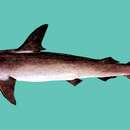Biology
(
Inglês
)
fornecido por Arkive
Known for their spectacular schooling behaviour, the smooth hammerhead gathers into these large groups as juveniles, but as adults they occur singly or in small groups. They hunt for bony fish, small sharks and stingrays and are known to be cannibalistic on occasion. When inshore, their diet consists mainly of skates and stingrays. Pinning their prey down with the hammer, the smooth hammerhead bites chunks from the wings of the stingray until it is immobilised. It is not unusual to see hammerheads with the barbs from stingrays implanted into their heads. In deeper waters they may also feed on crustaceans and cephalopods. In northern Europe, the smooth hammerhead eats mainly herring and bass, and in the Mediterranean, it is known to scavenge from longline fisheries. Other large shark species may prey on juvenile smooth hammerheads, but adults have no natural predators (2). The hammer-shaped head is thought to be a mechanism to spread out the ampullae of Lorenzini – sensory organs that detect electric currents, chemicals in the water, and temperature changes (6).
During an 11 – 12 month gestation, the eggs of the smooth hammerhead hatch inside the female's body. The embryos are nourished by a yolk sac placenta and during the summer months, once the yolk sac has been used, between 20 and 40 young sharks hatch. Measuring just 0.5 m at birth, males and females reach maturity at 2.1 – 2.5 m and 2.7 m respectively (2).
The smooth hammerhead migrates northward during the summer to find cooler water. When overheating, it can be seen swimming slowly at the surface with the dorsal fin out of the water (5).
Conservation
(
Inglês
)
fornecido por Arkive
Shark-fining is banned in US waters, and the smooth hammerhead is a prohibited target species in New Zealand waters. Despite relatively few attacks on humans, many people fear hammerhead sharks and so conservation efforts can be difficult. Currently this species is not immediately threatened with extinction, and whilst there is much research into its ecology and physiology, there is little targeted conservation action (2).
Description
(
Inglês
)
fornecido por Arkive
A member of a large and easily recognisable group of sharks, the smooth hammerhead can be distinguished from the other hammerhead species by the single notch in the centre of its hammer-shaped head. The eyes are located at either end of the hammer, and the particularly arched mouth is in line with the trail edge of the head (3). Olive-grey above and white below, the smooth hammerhead has a tall and sickle-shaped first dorsal fin and plain pectoral fins with black tips (4).
Habitat
(
Inglês
)
fornecido por Arkive
Preferring shallow waters, the smooth hammerhead in usually found inshore over continental shelves, or in bays and estuaries. It may also be found well offshore in deeper waters, particularly when migrating. The smooth hammerhead has also been seen in freshwater habitats such as the Indian River, along the coast of Florida, USA (2).
Range
(
Inglês
)
fornecido por Arkive
The smooth hammerhead is widespread in temperate and tropical waters, including the Atlantic, Pacific and Indian Oceans and the Mediterranean and Black Seas. It migrates northward in search of cooler waters for the summer months (3).
Status
(
Inglês
)
fornecido por Arkive
The smooth hammerhead is classified as Lower Risk – near threatened (LR/nt) on the IUCN Red List (1).
Threats
(
Inglês
)
fornecido por Arkive
The smooth hammerhead is rarely fished intentionally, but may be used for its liver oil in vitamins, its fins for shark fin soup in Asia, its hide for leather and the carcass is used as fishmeal (2). It forms part of accidental catch in gillnet, longline and driftnet fishing operations but, as the fins are prized in Asia, it is rarely released alive when caught (3).

